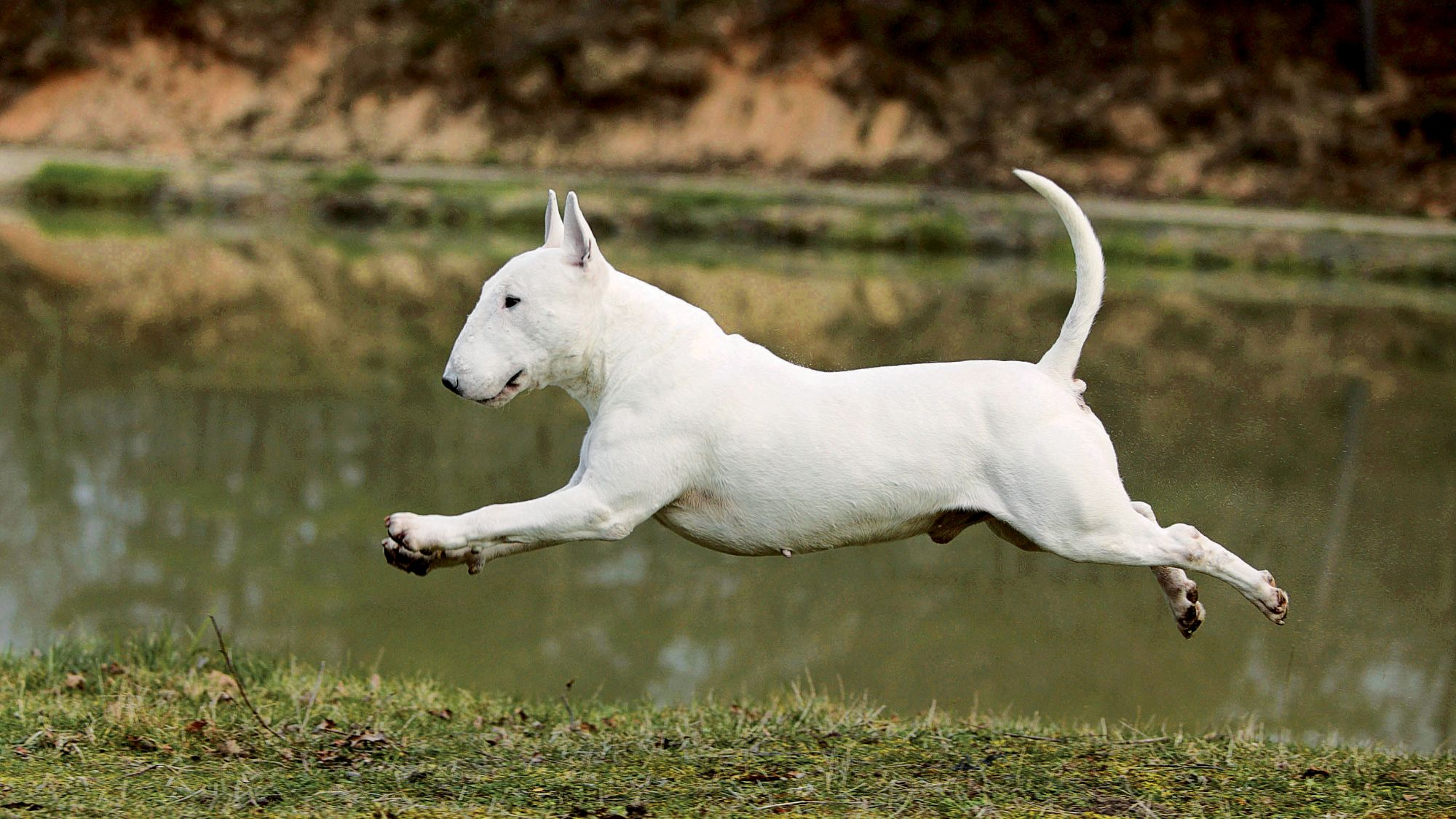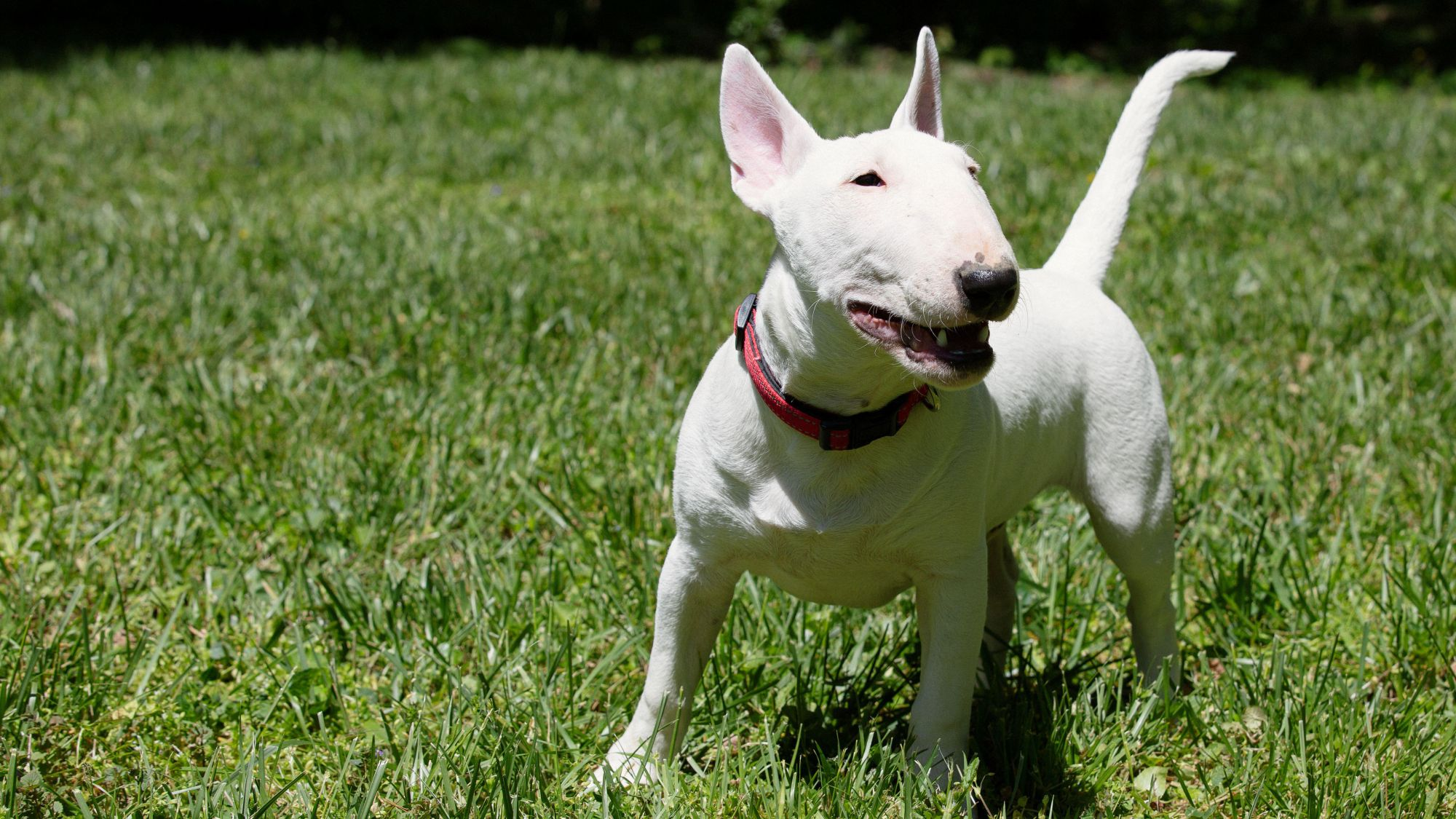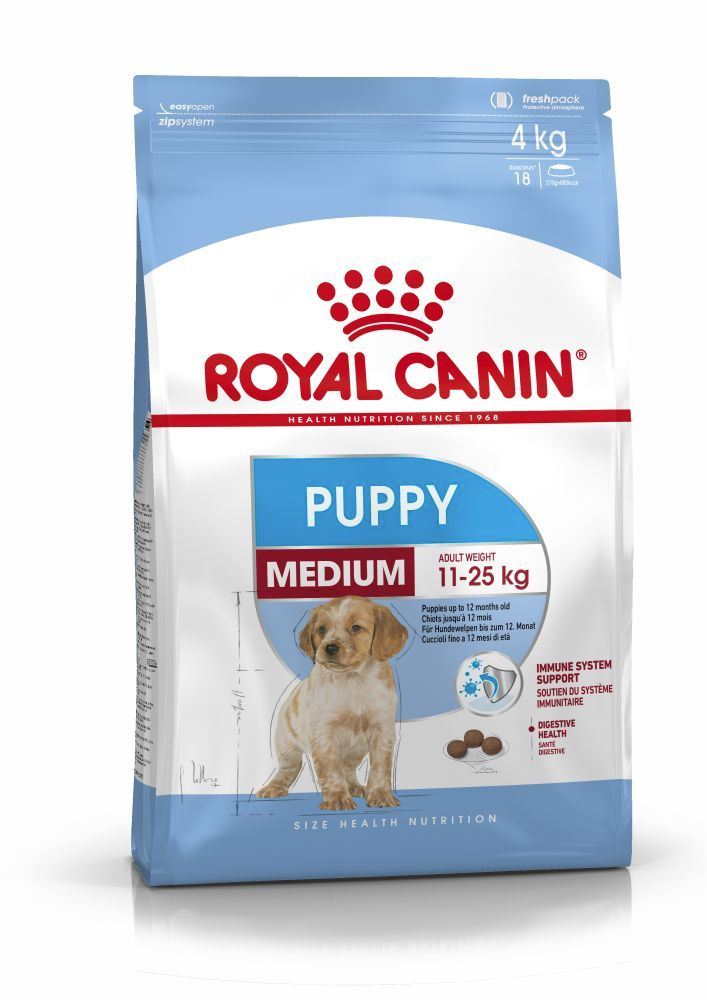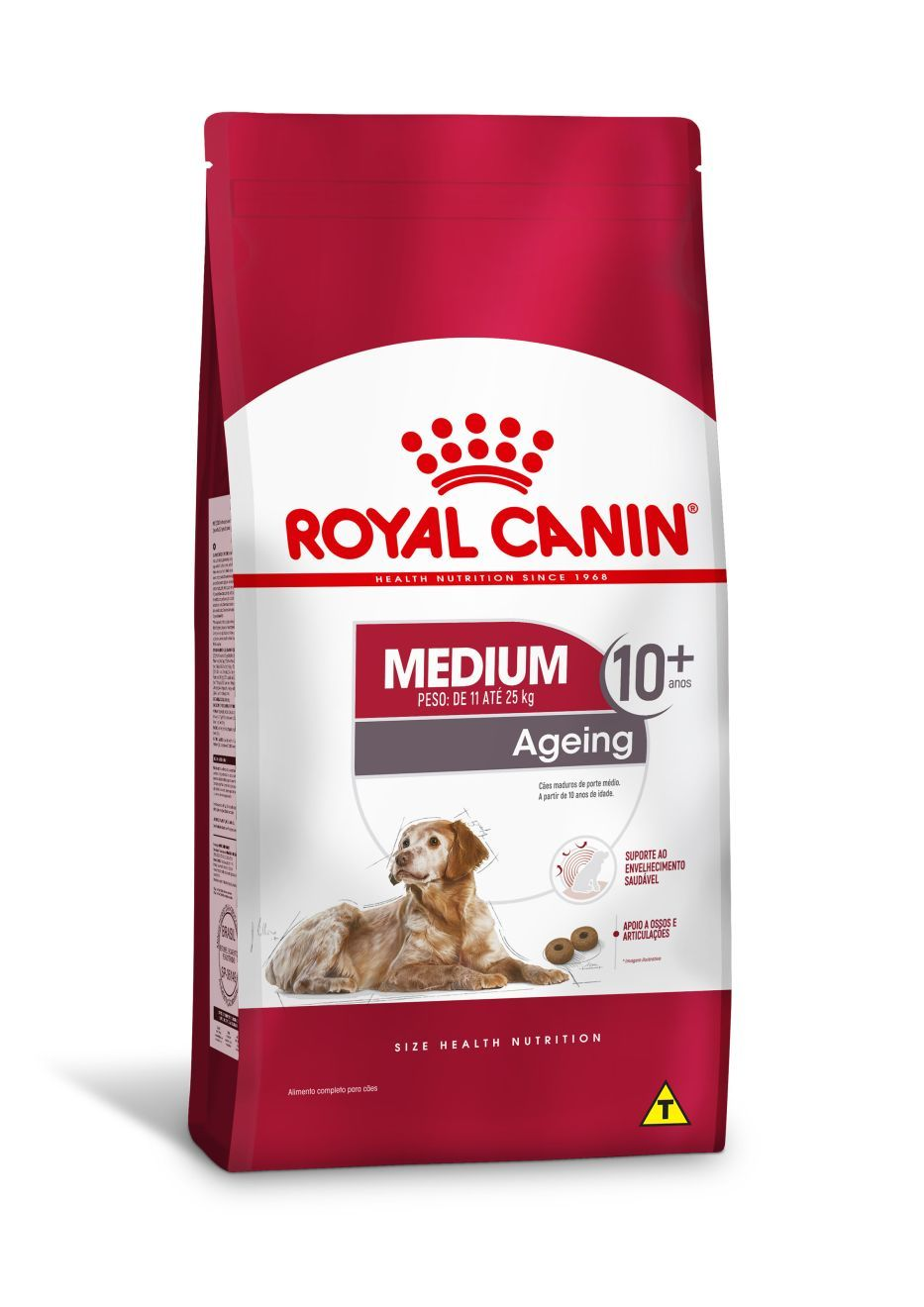Let's talk Bull Terriers
The Bull Terrier lives up to the canine moniker of ‘(wo)man’s best friend’. They welcome anyone and everyone with open paws, making them a faithful and affectionate companion. You will find the Bull Terrier wherever the action is, as they like to stay busy and as close as possible to their people. Their intelligence makes the Bull Terrier a fantastic playmate and with consistent training, the Bull Terrier is a welcome addition to the family unit, capable of getting on very well with children.
Official name: Bull Terrier
Other names: English Bull Terrier, Bully
Origins: United Kingdom
Drooling tendencies
1 out of 5Shedding Level
3 out of 5Energy level*
3 out of 5Compatibility with other pets
4 out of 5Warm weather?
4 out of 5Suited to apartment living
4 out of 5Family pet?*
5 out of 5Can stay alone
2 out of 5
| Male | Female |
|---|---|
| Height | Height |
| 56 - 57 cm | 53 - 54 cm |
| Weight | Weight |
| 25 - 30 kg | 20 - 25 kg |
| Life stages | |
|---|---|
| Adult | |
| 1 to 7 years | |
| Mature | Senior |
| 7 to 10 years | 10 years onwards |
| Baby | |
| Birth to 2 months | |
Drooling tendencies
1 out of 5Shedding Level
3 out of 5Energy level*
3 out of 5Compatibility with other pets
4 out of 5Warm weather?
4 out of 5Suited to apartment living
4 out of 5Family pet?*
5 out of 5Can stay alone
2 out of 5
| Male | Female |
|---|---|
| Height | Height |
| 56 - 57 cm | 53 - 54 cm |
| Weight | Weight |
| 25 - 30 kg | 20 - 25 kg |
| Life stages | |
|---|---|
| Adult | |
| 1 to 7 years | |
| Mature | Senior |
| 7 to 10 years | 10 years onwards |
| Baby | |
| Birth to 2 months | |

Get to know the Bull Terrier
All you need to know about the breed
There is never a dull moment with a Bull Terrier around. Friendly. High energy. Loyal. They are a charming breed, who also like to play the class clown from time to time. With their unique egg-shaped head, they have won hearts many times over.
Active types need only apply! Exercise for your Bull Terrier should be between 30 and 60 minutes per day, and they excel when given fun tasks such as flyball or agility exercises. The Bull Terrier suits a confident owner, who will be firm and constant in their approach to training, taking the breed’s stubborn streak in their stride. Overall, teaching your Bull Terrier should be a pleasant experience for both parties, as the breed learns quickly and likes to please their owners.
The Bull Terrier much prefers to be around people and does not do well if left to their own devices. Early socialisation makes for a super sociable canine, who is great at being a guard dog, and feels comfortable in a crowd.
The Bull Terrier is always down to play, which makes them great company for older children who show them respect. Younger children however may find the breed a little too boisterous - he never means any harm but just gets over excited when the fun happens. However, if you’re looking for an affectionate and loving canine companion and enjoy a good amount of daily exercise, then the Bull Terrier may well be the breed for you.

2 facts about Bull Terriers
1. Mister Lonely
A Bull Terrier prefers company, so this is not the breed for you if work involves travel or long days away from home. If left to entertain themselves, they are likely to eat anything they can sink their teeth into. A Bull Terrier will not expect your undivided attention 24/7, they just love being around people! Social butterflies, if you will.
2. More exercise please
Exercising a Bull Terrier is not just physical, they also need their minds to stay sharp on a daily basis. Take your Bull Terrier for a jog or a long walk - always on a leash to prevent them wandering off - but also buy them interactive toys that will work their brain cells. The Bull Terrier will expend their energy in whatever way paw-sible, so the more entertaining you make it for them, the more devoted they will be to you.

History of the breed
Let’s rewind to 1835, when the Bull Terrier first appeared on the scene. A cross between a Bulldog and an English Terrier (now extinct), the Bull Terrier was known for its strength and success in the dog-fighting ring.
In 1860, an Englishman named James Hinks set out to create a white coated Bull Terrier, which set a new trend. Suddenly the breed became the must-have companion of distinguished gentlemen throughout England. This led to them being nicknamed “White Cavalier”, because of their dignified manner towards people while also being ferocious in the ring.
Happily, dog-fighting is now a thing of the past but the Bull Terrier remains as sweet and friendly as ever - with a silly side to boot that they’re not afraid to reveal. The American Kennel Club (AKC) first registered the breed in 1885, with a Bull Terrier named Nellie II. In 1936, the coloured Bull Terrier variety was officially recognised, and more recently, in 1992, the Miniature Bull Terrier was recorded as a separate breed
Much like his distant relatives, the American Staffordshire Terrier and the Staffordshire Bull Terrier, many still believe the Bull Terrier of today to be some sort of canine gladiator. Brave, yes. Likes to stay active, also yes. But in reality, the Bull Terrier makes for an affectionate and loyal companion - for life.
From head to tail
Physical characteristics of Bull Terriers
1.Head
2.Ears
3.Eyes
4.Coat
5.Body

Things to look out for
From specific breed traits to a general health overview, here are some interesting facts about your Bull Terrier
Skin type: sensitive
Bull Terriers are a pretty healthy breed in general, but one thing to look out for is sensitive skin, especially those with a white coat. The breed can also have contact allergies with dust, pollen or washing detergents. Keep a close eye out for rashes or irritations during the weekly brush, which can be easily treated by your vet. There are also long-term treatment options if necessary, to keep your Bull Terrier feeling good!
Spinning around
Young Bull Terriers (6 months +) can sometimes develop an obsession for chasing their tail. Often, this suggests that they are bored, in which case there’s a simple solution. More exercise, both physical and mental! Play a game with your Bull Terrier or distract them with a nice walk outside. If this doesn’t work, don’t go into a tailspin of your own. Consult your vet, who will either suggest a medication to help your canine companion or refer you to a trusted behaviorist.
Healthy diet, healthier dog

When choosing food for a Bull Terrier, there are many factors to consider: their age, lifestyle, activity level, physiological condition, and health including potential sickness or sensitivities. Food provides energy to cover a dog’s vital functions, and a complete nutritional formula should contain an adjusted balance of nutrients to avoid any deficiency or excess in their diet, both of which could have adverse effects on the dog.
Clean and fresh water should be available at all times to support good urinary regularity. In hot weather and especially when out exercising, bring water along for your dog’s frequent water breaks.
Energy intake may also have to be adapted to the climatic conditions. A dog that lives outdoors in winter will have increased energy requirements.
The following recommendations are for healthy animals. If your dog has health problems, please consult your veterinarian who will prescribe an exclusively veterinary diet.
A Bull Terrier puppy’s requirements, in terms of energy, protein, minerals, and vitamins, are much greater than those of an adult dog. They need energy and nutrients to maintain their body, but also to grow and build it. Until they are 12 months old, a Bull Terrier puppy’s immune system develops gradually. A complex of antioxidants - including vitamin E - can help support their natural defences during this time of big changes, discoveries, and new encounters. Their digestive functions are different from an adult Bull Terrier’s, too: their digestive system is not mature yet so it’s important to provide highly digestible proteins that will be effectively used. Prebiotics, such as fructo-oligosaccharides, support digestive health by helping balance the intestinal flora, resulting in good stool quality.
Similarly, a puppy’s teeth – starting with the milk teeth, or first teeth, then the permanent teeth – are an important factor that needs to be taken into account when choosing the size, shape, and texture of kibble. This short growth phase also means high energy needs, so the food must have a high energy content (expressed in Kcal/100g of food), while concentrations of all other nutrients will also be higher than normal in a specially formulated growth food. It is recommended to split the daily allowance into three meals until they are six months old, then to switch to two meals per day.
Throughout their life, it is important to avoid feeding Bull Terriers human foods or fatty snacks. Instead, reward them with kibble taken from their daily meal allowance, and strictly follow the feeding guidelines written on the package in order to prevent excessive weight gain.

The main nutritional goals for adult Bull Terriers are:
Maintaining an ideal body weight by using highly digestible ingredients and keeping the fat content at a sensible level
Promoting optimal digestibility with high quality protein and a balanced supply of dietary fibre
Helping to preserve the health and beauty of the skin and coat with the enriched addition of essential fatty acids (especially EPA-DHA), essential amino acids, and B vitamins.
To help support their natural defences, a formula enriched with an antioxidant complex and containing mannan-oligosaccharides is recommended.

At around 7 years old, Bull Terriers start facing the first signs of ageing. A formula enriched with antioxidants will help maintain their vitality, and specific nutrients, such as chondroitin and glucosamine, will help maintain healthy bones and joints. Ageing is also accompanied by the modification of digestive capacities and particular nutritional requirements, so food for older Bull Terriers should have the following characteristics:
Higher vitamin C and E content. These nutrients have antioxidant properties, helping to protect the body’s cells against the harmful effects of the oxidative stress linked to ageing.
High-quality protein. Contrary to a widely held misconception, lowering the protein content in food brings little benefit in limiting kidney failure. In addition, older dogs are less efficient at using dietary protein than younger dogs. Reducing the phosphorous content is a good way of slowing down the gradual deterioration of kidney function.
A higher proportion of the trace elements iron, zinc, and manganese to help maintain the good condition of the skin and coat.
A higher quantity of polyunsaturated fatty acids to help maintain the quality of the coat. Dogs can normally produce these fatty acids, but ageing can affect this physiological process.
As they age, dogs increasingly suffer from teeth problems. To ensure they continue to eat in sufficient quantities, the shape, size and hardness of their kibble needs to be tailored to their jaw.

Caring for your Bull Terrier
Grooming, training and exercise tips
7/7
All about Bull Terriers
100% yes. The Bull Terrier is an affectionate dog, who is capable of being equally devoted to all family members. The Bull Terrier also has a mischievous side, which makes them an entertaining companion, and they’re content to tire themselves out playing with older children. Teaching the Bull Terrier good social skills from when they are a puppy will result in a placid companion who is loyal until the very end.
When it comes to protecting the ones that they love, the Bull Terrier is top of the class. The breed’s muscular physique is often enough of a deterrent for wannabe burglars, especially when coupled with their loud bark, which the Bull Terrier rarely uses. Word of warning, the Bull Terrier’s natural protective instincts should not be developed any further - keep the breed a lover, not a fighter.
Suggested Breeds
Read more on this topic
Sources
- Veterinary Centers of America https://vcahospitals.com/;
- Royal Canin Dog Encyclopaedia. Ed 2010 and 2020
- Banfield Pet Hospital https://www.banfield.com/
- Royal Canin BHN Product Book
- American Kennel Club https://www.akc.org/
Like & share this page